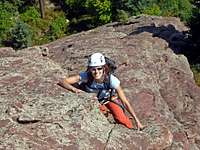|
|
Route |
|---|---|
|
|
39.98735°N / 105.29347°W |
|
|
Trad Climbing |
|
|
Summer, Fall, Winter |
|
|
Half a day |
|
|
5.5 (YDS) |
|
|
6 |
|
|
II |
|
|
Overview
Take a celebrated route like the Standard East Face on the Third Flatiron; subtract the crowds and the eyebolts, keep the quality, and add 350 feet of climbing and a little bushwhacking. The result is the East Face South Side route--not only the longest route around Boulder (1300 feet), but one of the very best easy climbs in the area.All routes on the Third Flatiron, including this one, are subject to seasonal closures. Access is usually forbidden from February 1st to July 31st. Check here and here for up-to-date information.
Getting There
It is fair to assume that the approach is responsible for the relatively low traffic on this route. Instead of the well-marked trail to the East Bench, one has to follow a steep, very faint path that eventually peters out. It is only a few minutes' bushwhack, though. Start from the Chautauqua parking lot, reach Bluebell Shelter, and take the Royal Arch Trail. Continue on that trail past the fork whose right branch is marked as access to the Second and Third Flatirons. About 50 feet before the crossing of Bluebell Canyon, a very faint trail climbs up toward the Third. Follow this faint trail, which skirts a talus field, contours the Third Flatironette, goes though some boulders, and finally deposits you at the base of the Third Flatiron.Route Description
From the base of the Third Flatiron, climb an easy ramp that angles right to a shallow bowl. Since the base of the rock is infested by ferns, it is convenient to rope up at the bowl; from there, the summit can be reached in six pitches with a 60 or 70 m rope.The first pitch takes you under an overhang that crosses the lower part of the east face. The overhang can be circumvented on the left on the very edge of the face (5.5) or attacked directly via one of two cracks (5.7). There is no consensus on which crack offers the easier passage. Expect to use every meter of your 60 m rope on this pitch. If you start from the base of the Third, two pitches are necessary to reach the overhang even with a 70 m rope. We went by an old unreliable bolt, but we did not clip it.
Above the overhang, one climbs for three long pitches on flakes and textured slabs (5.easy). Multiple lines are possible: Ours stayed close to the edge of the face and went by the top anchor (two bolts and chain) of Shoyu State (a 5.11a route on the south face). Another party that had started before us kept further to the right. At the end of the fourth pitch you will find yourself to the left and above the giant C painted on the east face. You may spy the last eyebolt of the Standard Route near the top right corner of that C.
The fifth pitch presents one with a choice. One can keep to the left and climb the secondary summit known as Dog's Head and from there continue for 250 feet to the summit. Alternatively, one can angle right towards the top of the Gash. A last pitch crosses the Gash at the height of the South Bowl, and merges with the direct finish to the Standard Route (5.4).




nicksintros - Sep 24, 2007 9:43 am - Hasn't voted
GearThe path I took, which doesn't seem far from the directions given in the article didn't have many options for gear, with run outs of around 100' I would guess. I would give the climb an R rating because of this. Aside from this the climb was great fun.
brenta - Sep 24, 2007 12:37 pm - Hasn't voted
Re: GearRunouts of 100 feet mean half a pitch without placing any pro. That does not match my recollection of this route, but sometimes, when the climbing is easy, one is inclined to "run it out" rather than spending time looking for where to place protection. In sum, while all east face routes on the Flatirons are runout to some extent, when I think of R routes on the Flatirons, definitely this one does not come to mind.